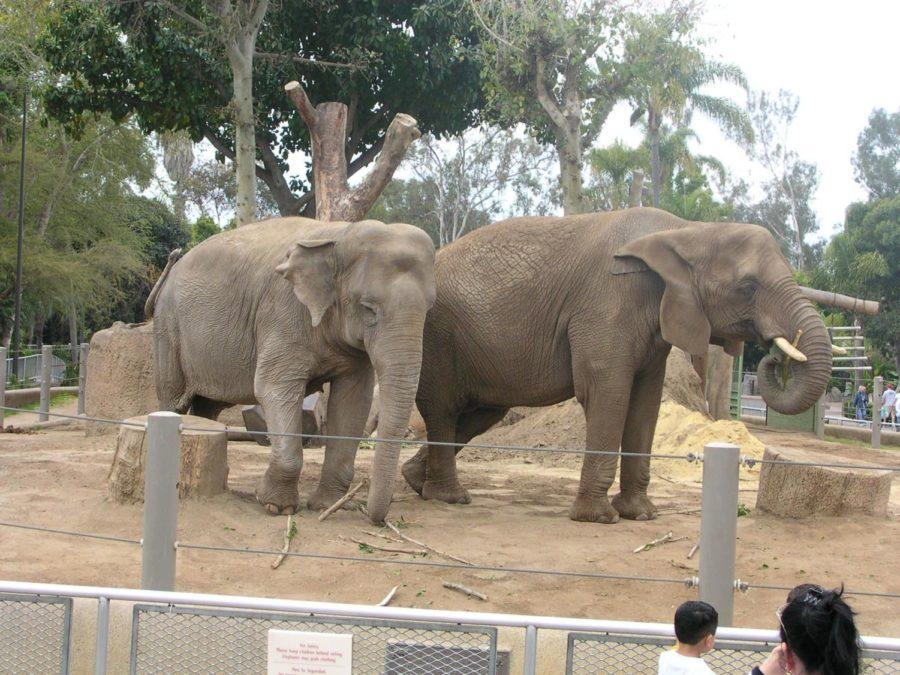Tyrrell: Free the elephants
Elephants
June 5, 2019
When I was a child, my parents took me and my siblings to the circus. It was so exciting to watch trapeze artists swing high above the crowd and motorcyclists ride in gravity-defying loops, but my favorite part was always the animals — lions jumping through hoops, dogs performing tricks and, of course, the elephants. One year, I actually got to ride an elephant, in the little fair area surrounding the giant colorful tent. I climbed up a staircase, clambered onto the elephant’s back and rode in glee as it did a lap around the enclosure.
At the time, riding the elephant was special and exciting. Looking back, I just feel sad.
This was probably in 2007 or 2008, before the movement to shut down animal acts in circuses really took off. My parents weren’t aware of the abuse circus animals suffered, and I certainly wasn’t thinking about it. Luckily, thanks to public pressure and legislative efforts to end the practice, the use of exotic animals in circus acts is becoming more and more unpopular. Although, as of 2017, there were still over 200 animals working in circuses in the United States.
What’s still alive and well, however, is wildlife tourism. Unfortunately, wildlife tourism — while still intensely cruel to animals — is a lot less blatantly abusive than circus acts and is therefore tricky to get rid of. Think people riding elephants in Thailand, taking selfies with sloths in South America, even swimming with dolphins at Disney. Something about the fact that these tourist traps often take place in the animals’ home countries, as well as the extreme efforts the animal wranglers go to to keep up the false appearance of humane treatment, makes them harder to pinpoint as abusive practices.
But a recent National Geographic article spills it wide open. It is never natural or healthy for wild animals to interact closely with humans. Animals such as sloths and tigers are drugged and declawed before tourists can take selfies with them; dolphins are kept in small, shallow enclosures, living in the same conditions that caused SeaWorld to shut down its orca shows.
Perhaps worst of all is the practice of “breaking” elephants before they can interact with humans. Between the ages of 3-6 years old (the equivalent of toddler age; wild elephants can live up to 70 years) elephants to be used for tourism are “broken” in a process known as phajaan. This process includes starving, beating and torturing an elephant for weeks before its spirit is crushed and it becomes submissive to humans.
Even increasingly popular “elephant sanctuaries,” where tourists can bathe elephants and watch them paint, are not what they seem. I could list half a dozen influencers, or even real people I know, who have espoused giving elephants baths instead of riding them because it’s more humane. Usually the message is accompanied by an adorable Instagram post showing said person and elephants frolicking in a beautiful river. But it’s not in an elephant’s natural behavior to spend hours a day being washed by humans or painting with a paintbrush, and the elephants in such sanctuaries will still have been cruelly broken to make them willing to interact with humans.
When I learned about this practice, and the fact that it still exists today, I was completely horrified. National Geographic writer Natasha Daly put it into brutal terms in her article “The Wildlife We See, the Suffering We Don’t,” published in the June 2019 magazine: “A four-year-old human child with spikes pressing into his flesh would express pain by screaming. A four-year-old elephant just stands there in the rain, her leg jerking in the air.”
It never crossed my mind to think that the elephant I myself rode as a child could have been tortured into submission when she was just a baby. And just within the past couple months, I paid to take a picture holding captive animals twice – an eagle owl in Edinburgh, and a python in Prague. Now I realize that the animals had probably been drugged.
It’s so easy to excuse ourselves from the mistreatment and abuse of animals because we don’t actually see it. But people like us — privileged Americans, entering prime vacation time — are exactly who fuels the wildlife tourism industry. It’s incredibly captivating to travel to a foreign country and get to interact with the exotic animals there, whether that’s by taking selfies with tigers in Asia or swimming with dolphins in the Caribbean (or posing with a python in Prague). But I think most tourists would be appalled by their actions if they realized the kind of abuse and cruelty they were funding.
So this summer, and any time you have the opportunity to interact with wild animals, ask yourself if you would ever see an animal in the wild acting the same way. Cheetahs do not like posing in pictures with people. Dolphins and manatees don’t like swimming with us in pools. And elephants do not like painting, or carrying people around, or splashing around with us in pools for hours. Chances are those animals have been cruelly coerced and abused into exhibiting those behaviors and your money is further supporting the industry.
And please, spread the word. My parents don’t support elephant abuse and neither does my friend who traveled to Thailand or that Instagram influencer on your feed. The problem is, people don’t realize what goes on behind the beautiful pictures. Only by spreading knowledge and awareness of these horrible practices can we end them once and for all.
















